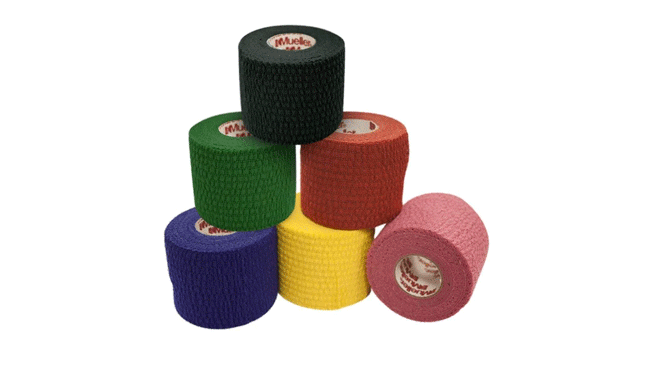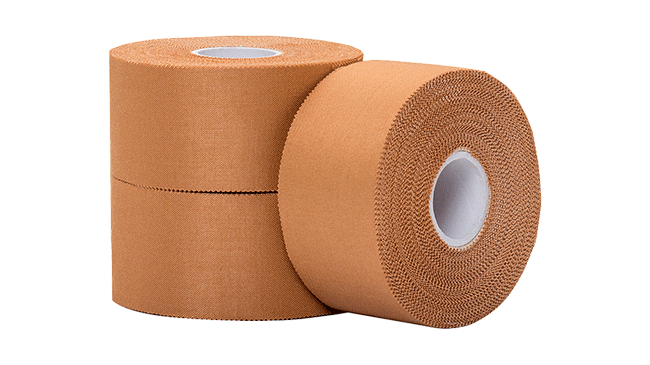Buyers Guide to Rugby Strapping Tape
Rugby strapping tape is widely available in most rugby-playing nations, such as New Zealand, the United Kingdom, South Africa and Australia. Read this buyer’s guide for tips and advice on choosing the best strapping tape or bandages for your rugby team.

Rugby is a high-intensity physical sport that requires players to take precautions to prevent injury. Strapping, tape and bandages are essential rugby equipment for any coach or player’s safety arsenal. Whether on the pitch training, playing in a match or recovering from an injury, having quality strapping tape and bandages can make all the difference.
When choosing rugby strapping, tape or bandages, it is important to consider the type of activity you will be doing and the level of support required. It is also important to make sure that the tape or bandage is of good quality and appropriate for the area of the body it will be covering.
Considering comfort when using rugby strapping tape and bandages is also important. Many players find that certain types of tape can cause discomfort or skin irritation if not used correctly. It is, therefore, essential to read instructions carefully before use and ensure that any additional padding is in place to protect the skin.
By following the tips on this page, coaches, players and support staff can ensure that they are using the right product for their needs and that it will provide the necessary support, stability and comfort.
Three Types of Strapping
The three types of strapping tapes used in rugby union, on and off the field, are EAB (Elastic Adhesive Bandage), Zinc Oxide Tape and Kinesiology tape.
Elastic Adhesive Bandages (EAB)
Elastic Adhesive Bandages (EAB) are one of the essential pieces of equipment that rugby players can purchase for their sport. They provide support and stability to the body and help prevent injuries. Knowing which Elastic Adhesive Bandage suits your team or athlete can be complex, with many types available.

What is an Elastic Adhesive Bandage (EAB)?
Elastic Adhesive Bandages (EAB) are adhesive bandages that can be stretched to support and stabilise muscles and joints. They are commonly used to help reduce swelling, improve circulation, and prevent injury.
EABs are also used in rugby for thumb taping, a technique used to help support the thumb joint and protect it from further injury.
What is an Elastic Adhesive Bandage (EAB)?
Elastic Adhesive Bandages (EAB) are adhesive bandages that can be stretched to support and stabilise muscles and joints. They are commonly used to help reduce swelling, improve circulation, and prevent injury.
EABs are also used in rugby for thumb taping, a technique used to help support the thumb joint and protect it from further injury.
EAB Benefits for Rugby
Elastic Adhesive Bandages provide many benefits for rugby players. They help reduce swelling, improve circulation, and provide stability and support for muscles and joints. EABs can also be used for thumb taping, which helps support the thumb joint and prevents further injury. Additionally, they are lightweight and can easily fit into a player’s equipment bag without taking up too much space.
Zinc Oxide Tape

Zinc oxide tape is a thin, flexible adhesive tape that provides firm support and protection for athletes who play physical sports, such as rugby.
What is Zinc Oxide Tape?
Zinc oxide tape is an adhesive tape made from a zinc oxide-based elastomeric material. It’s often used in rugby to help protect skin from injury, such as abrasions. It’s also used to help stabilize joints and reduce the risk of sprains or strains. The tape is flexible, lightweight, breathable, and comfortable for long periods, making it an ideal choice for rugby players.
Zinc oxide tape is also waterproof, so you can keep your skin dry and protected even when playing in wet conditions, making it an excellent choice for rugby players who often play in wet or muddy conditions. The tape won’t be affected by water and will still provide strong support and protection for players, even when their skin is exposed to moisture.
Different Types of Rigid Tapes Available to You
Several types of rigid zinc oxide tapes are available, and the right style for you will depend on the kind of protection you need. For instance, rigid tapes can offer extra support and stability for players at risk of sprains or strains and those who need additional protection against abrasions. There are also stretchable tapes available which provide a more comfortable fit and better range of motion.
Different Types of Rigid Tapes
Several types of rigid zinc oxide tapes are available, and the right style for you will depend on the kind of protection you need. For instance, rigid tapes can offer extra support and stability for players at risk of sprains or strains and those who need additional protection against abrasions. There are also stretchable tapes available which provide a more comfortable fit and better range of motion.
Kinesiology Tape

Kinesiology tape is an ideal solution to help players rehabilitate injuries and increase physical performance. It can be used on almost any body part, providing support and pain relief while allowing a full range of motion without restriction.
What is Kinesiology Tape?
Kinesiology tape is a stretchy, hypoallergenic material applied directly to the skin to provide support and relief from pain. It provides a stabilizing effect that allows athletes to move freely while reducing muscle tension and strain. Kinesiology tape is made of a special material that stretches in four directions, which helps it conform to the body’s shape for maximum support.
Kinesiology Tape Benefits and Uses
Kinesiology tape can help athletes recover from injuries more quickly and reduce pain associated with overuse. The tape helps athletes move more freely while avoiding further injury by providing support and stability. The tape also helps promote lymphatic drainage, reducing swelling and inflammation. Additionally, the tape helps to improve posture, enhance proprioception, and increase range of motion.
Kinesiology Tape for Rugby Players
Rugby players are especially prone to injuries due to the physical nature of the sport. Kinesiology tape is an ideal solution for injury prevention and enhanced performance. The tape can support and stabilize joints, reduce pain associated with overuse, and help rugby players move more freely. The tape can also improve posture, enhance proprioception, and increase range of motion.
When it comes time to buy kinesiology tape for rugby players, there are a few tips that buyers should consider:
- Make sure the tape is made of a durable material that won’t tear or stretch too much.
- Consider the thickness and amount of adhesive on the tape to ensure it can withstand the rigours of rugby.
- Make sure to buy enough tape to cover any areas needing support or relief from pain.
FAQs
When showering after the game, many players find that traditional strapping tape is not waterproof and quickly becomes loose or torn. Many rugby players are now turning to waterproof strapping tape, such as the D3 rayon-cotton blend tape with its zinc-oxide adhesive.
Waterproof strapping tape is designed to stay on when wet, which makes it ideal for showering after a game or training session. It’s also much more durable than traditional strapping tape, as it won’t become loose or torn due to contact with water.
As well as being water-resistant, waterproof strapping tape also offers extra support for rugby players’ joints and muscles, as the material is made to be flexible, allowing it to move with the body while still providing the necessary support.
The adhesive used for waterproof strapping tape tends to be stronger than traditional adhesive, so it will remain stuck in place, even when wet.
For players who suffer from allergies or sensitive skin, traditional strapping tapes can cause a reaction. Thankfully, there is now an alternative: hypoallergenic strapping tape.
Hypoallergenic strapping tape, such as the Kinesiology TEX tape from R80, is manufactured for those with sensitive skin and allergies. These tapes are made from non-irritating adhesive materials, allowing the player to wear the tape without the risk of a reaction.
In addition, hypoallergenic tapes are clinically tested to be gentler on the skin than traditional strapping tape. As a result, they can be worn for extended periods without the risk of skin irritation or other allergic reactions.
Hypoallergenic strapping tape is available in various sizes and colours, making it easy to find the perfect fit for your needs. In addition, these tapes are designed to be comfortable and easy to apply, with some even featuring self-adhesive backing for quick and easy application.
Hypoallergenic strapping tape is a great way to provide support without sacrificing comfort for rugby union players. These tapes are lightweight and designed to move with the body, making them perfect for providing joint stability and muscle protection during intense physical activities.
Hypoallergenic strapping tape can also help protect against scrapes and bruises, as it has been tested to be gentle and firm. With suitable tape, rugby union players can help prevent skin irritation and other allergic reactions while enjoying the full benefits of their sport.
Many players suffer from rashes and allergies caused by the adhesive in strapping tape.
The adhesive in the strapping tape is typically composed of acrylate and methacrylate, commonly used to produce adhesives. These materials can cause allergic reactions when they come into contact with sensitive skin, leading to a rash or reaction. In some cases, the rash may only appear where the strapping tape was applied, while in others, it may spread to other parts of the body.
The chemicals used in some brands of strapping tape can also irritate people with sensitive skin. Ingredients such as isobutyl methacrylate and ethyl acrylate can be especially problematic for people prone to allergies or rashes. If you have sensitive skin, paying attention to the ingredients in any strapping tape you use and avoiding those with these substances is essential.
It’s also important to ensure that the strapping tape is applied correctly. Improper application can cause the adhesive to come into contact with the skin and cause a reaction. Before applying the strapping tape, ensure it is clean and free of dirt or debris. Also, avoid applying the tape too tightly, as this can cause the adhesive to come into contact with the skin and cause an allergic reaction.
Finally, if you get a rash or reaction from strapping tape, treat it with an anti-itch cream or ointment. If the inflammation persists for over three days, consider seeing a doctor to rule out other underlying causes.
